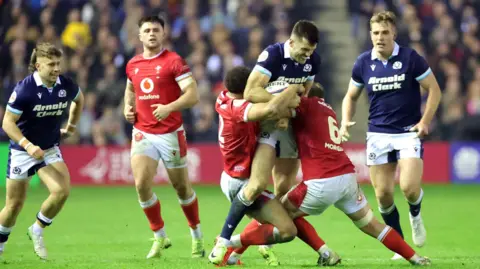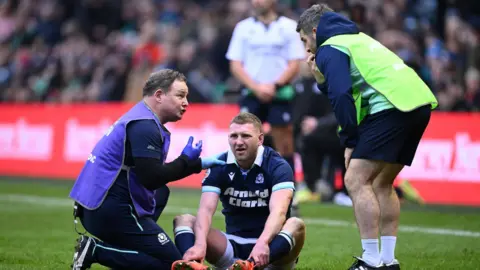BBC Scotland News
 PA Media
PA MediaLowering the tackle height in men’s rugby almost halved the rate of head collisions among players, a study at Edinburgh University has found.
The lowered tackle height law was introduced for community rugby by World Rugby in the 2023/24 season in an attempt to improve safety for players.
Researchers at Edinburgh University used video analysis to study tackles from 60 men’s community matches in Scotland before the trial and during it, and found the law change resulted in a 45% reduction in head-on-head contact.
Experts previously found head-to-head contact was one of the primary causes of sports related concussion.
 Getty Images
Getty ImagesBoth rugby union and rugby league authorities are facing ongoing legal action from former players who have suffered brain injuries.
The study – which examined 18,702 tackles – also linked the law change to a 29% reduction in head-to-shoulder contact for the tackler and ball-carrier.
During the trial period in the 2023/24 season players were 22% more likely to tackle bent at the waist, the recommended technique to reduce player head proximity and contact.
Dr Debbie Palmer, of the Institute for Sport, Physical Education and Health Sciences at the Moray House School of Education and Sport, and co-director for the UK Collaborating Centre on Injury and Illness Prevention in Sport IOC Research Centre, said the findings were “very encouraging”.
The study’s lead author, Hamish Gornall – of Edinburgh University’s Moray House School of Education and Sport – added the study showed the rule change had proved “effective” in altering tackling behaviour.
He added: “Collecting prospective injury data, as well as continued monitoring of player behaviour across subsequent seasons would be beneficial to further investigate the implications of the change.”
World Rugby trial
The study is part of an international project led by World Rugby to assess the effects of lowering the tackle height in a host of countries, including France, New Zealand and Australia.
Researchers found no significant increase in tacklers’ heads coming into contact with the ball-carriers’ hips or knees, which is associated with an increased risk of head injury assessments and concussion diagnosis.
The trial was adopted by Scottish Rugby and made compulsory across all amateur playing levels.
Scottish Rugby chief medical officer Dr David Pugh said: “At Scottish Rugby we strive to reduce the incidence of concussion in as many ways as we can.
“We are also working with the university on an injury surveillance project, and we hope that this will see a significant drop in concussion rates due to the lower tackle height trial.
“Hamish’s research clearly demonstrates that player behaviours have changed, reducing head-to-head and head-to-shoulder contacts which should lead to reduced numbers of concussions in our players.”
In 2023 a study of former rugby players brains by Glasgow University found that out of 31 donated brains analysed, 21 had evidence of a condition linked to repeated head injuries and concussion.
A Durham University study last year suggested rugby players who have suffered multiple concussions have biological differences that may make them more prone to developing motor neurone disease (MND) – the condition that former Scottish internationalist Doddie Weir died from.
More than 1,000 former amateur and professional rugby union and rugby league players are currently involved in a long-running concussion lawsuit against the sports’ governing bodies.





